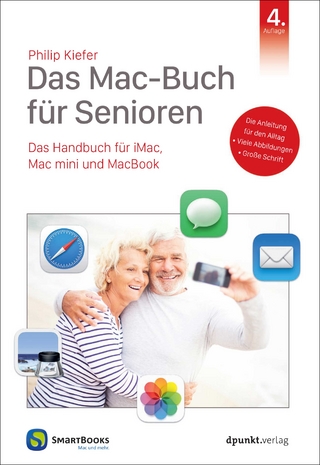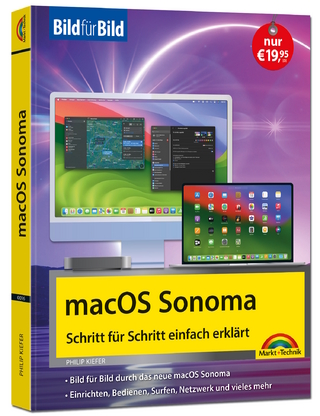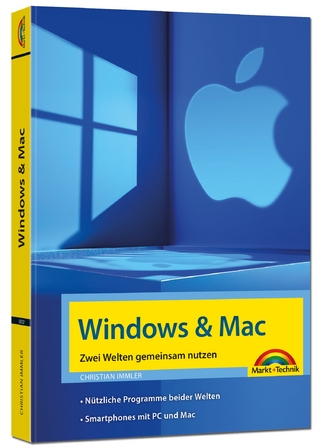
Cocoa Programming Developer's Handbook
Addison-Wesley Educational Publishers Inc (Verlag)
978-0-321-63963-9 (ISBN)
Yet for all its refined elegance and ease of use, the staggering size of the Cocoa family of APIs and the vast magnitude of the official documentation can be intimidating to even seasoned programmers.
To help Mac OS X developers sort through and begin to put to practical use Cocoa’s vast array of tools and technologies, Cocoa Programming Developer’s Handbook provides a guided tour of the Cocoa APIs found on Mac OS X, thoroughly discussing—and showing in action—Cocoa’s core frameworks and other vital components, as well as calling attention to some of the more interesting but often overlooked parts of the APIs and tools.
This book provides expert insight into a wide range of key topics, from user interface design to network programming and performance tuning.
David Chisnall has in-depth knowledge of Cocoa as both an implementer and a developer. He is an active contributor to the GNUstep project, which provides an open source implementation of the Cocoa APIs, and cofounded the Étoilé project to build a desktop environment atop GNUstep. He has created a new Objective-C runtime library, worked on Objective-C support in the clang compiler, and published papers on Objective-C. He wrote a popular series of articles on Objective-C and Cocoa for informIT.com and is the author of The Definitive Guide to the Xen Hypervisor (Addison-Wesley, 2008).
Part I: Introducing Cocoa
Chapter 1: Cocoa and Mac OS X
1.1 Understanding When to Use Cocoa
1.2 Understanding Cocoa's Role in Mac OS X
1.3 Overview
Chapter 2: Cocoa Language Options
2.1 Object Orientation
2.2 Objective-C
2.3 Ruby and Python
2.4 Summary
Chapter 3: Using Apple's Developer Tools
3.1 Obtaining Apple's Developer Tools
3.2 Interface Builder
3.3 XCode
3.4 Objective-C
3.5 Cocoa Conventions
3.6 Summary
Part II: The Cocoa Frameworks
Chapter 4: Foundation: The Objective-C Standard Library
4.1 General Concepts
4.2 Core Foundation Types
4.3 Basic Data Types
4.4 Collections
4.5 Enumeration
4.6 Property Lists
4.7 Interacting with the Filesystem
4.8 Notifications
4.9 Summary
Chapter 5: Application Concepts
5.1 Run Loops
5.2 Applications and Delegates
5.3 The Responder Chain
5.4 Run Loops in Applications
5.5 Delegates and Notifications
5.6 The View Hierarchy
5.7 Summary
Chapter 6: Creating Graphical User Interfaces
6.1 Positioning Views
6.2 Nested Views
6.3 Creating Views
6.4 Cocoa Bindings
6.5 Summary
Chapter 7: Windows and Menus
7.1 Understanding Windows
7.2 Creating Windows
7.3 Creating Window Objects
7.4 Panels
7.5 Sheets
7.6 Alert Dialogs
7.7 Menus
7.8 Summary
Chapter 8: Text in Cocoa
8.1 Constructing and Deconstructing Strings
8.2 Annotating Strings
8.3 Localization
8.4 Text Storage
8.5 Understanding Fonts
8.6 Displaying Text
8.7 Writing a Custom Text Container
8.8 Using Multiple Text Views
8.9 Summary
Part III: Cocoa Documents
Chapter 9: Creating Document-Driven Applications
9.1 The Cocoa Document Model
9.2 Creating the Application Skeleton
9.3 Creating the Document
9.4 Extending the Outliner
9.5 Supporting Undo
9.6 Adding Undo to the Outliner
9.7 Summary
Chapter 10: Core Data
10.1 Introducing Data Modeling
10.2 Understanding Managed Objects
10.3 Attribute Types
10.4 Creating a Data Model
10.5 Choosing a Persistent Store
10.6 Storing Metadata
10.7 Automatic Undo
10.8 Core Data, Spotlight, and Time Machine
10.9 Summary
Part IV: Complex User Interfaces
Chapter 11: Working with Structured Data
11.1 Data Sources and Delegates
11.2 Tables
11.3 Outline Views
11.4 Browsers
11.5 Collection Views
11.6 Customizing Views with New Cells
11.7 Creating Master-Detail Views
11.8 Summary
Chapter 12: Dynamic Views
12.1 Tabbed Views
12.2 Inspecting the View Hierarchy
12.3 Modifying the View Hierarchy
12.4 Creating Dynamic Input Forms
12.5 Full-Screen Applications
12.6 Summary
Part V: Advanced Graphics
Chapter 13: Custom Views
13.1 The Graphics Context
13.2 Core Graphics
13.3 AppKit Drawing
13.4 Printing and Paginating Views
13.5 Extending Interface Builder with Palettes
13.6 Summary
Chapter 14: Sound and Video
14.1 Beeping
14.2 Playing Simple Sounds
14.3 Understanding Cocoa Movie Objects
14.4 Adding Video
14.5 Editing Media
14.6 Low-Level Sound APIs
14.7 Sound and Video Recording
14.8 Supporting Speech
14.9 Cocoa Speech Synthesis
14.10 Conversing with Users
14.11 Summary
Chapter 15: Advanced Visual Effects
15.1 Simple Animation
15.2 Core Animation Overview
15.3 Understanding Animation Concepts
15.4 Adding Simple Animations
15.5 Image Filters
15.6 Defining Transitions
15.7 Creating Complex Animations
15.8 3D Core Animation Transforms
15.9 OpenGL and Cocoa Views
15.10 Quartz Composer
15.11 Summary
Chapter 16: Supporting PDF and HTML
16.1 HTML in AppKit
16.2 Advanced HTML Support
16.3 Dynamic Interfaces with WebKit
16.4 PDF and Quartz
16.5 Displaying PDFs
16.6 Summary
Part VI: User Interface Integration
Chapter 17: Searching and Filtering
17.1 Maintaining Document Indexes
17.2 Displaying Search Boxes
17.3 Searching for Documents
17.4 Spotlight
17.5 Predicates
17.6 Quick Look
17.7 Summary
Chapter 18: Contacts, Calendars, and Secrets
18.1 Address Book Overview
18.2 Getting Information About People
18.3 Searching the Address Book
18.4 Populating the "Me" vCard
18.5 Adding People to the Address Book
18.6 Storing Secrets
18.7 Calendars
18.8 Synchronizing Data
18.9 Summary
Chapter 19: Pasteboards
19.1 Pasteboard Overview
19.2 Pasteboard Types
19.3 Filtered Types
19.4 Property List Data
19.5 Self-Encoding Objects
19.6 Files and Pasteboards
19.7 Copy and Paste
19.8 Drag and Drop
19.9 Drag and Drop with Data Views
19.10 Summary
Chapter 20: Services
20.1 Example Services
20.2 An Evaluate Service
20.3 Using Services
20.4 Controlling the Services Menu
20.5 Filter Services
20.6 Summary
Chapter 21: Adding Scripting
21.1 Scripting Overview
21.2 Making Objects Scriptable
21.3 Scripting from Cocoa
21.4 Exposing Services to Automator
21.5 Other Scripting Technologies
21.6 Summary
Part VII: System Programming
Chapter 22: Networking
22.1 Low-Level Socket Programming
22.2 Cocoa Streams
22.3 URL Handling
22.4 Bonjour
22.5 Distributed Objects
22.6 Summary
Chapter 23: Concurrency
23.1 Distributed Objects
23.2 Threading
23.3 Child Processes
23.4 Operation Queues
23.5 Grand Central Dispatch
23.6 OpenCL
23.7 Summary
Part VIII: Appendixes
Chapter 24: Portable Cocoa
24.1 NeXT and Sun
24.2 Mobile OS X on the iPhone
24.3 OpenStep and GNU
24.4 GNUstep
24.5 QuantumSTEP
24.6 Cocotron
24.7 GNUstepWeb and SOPE
Chapter 25: Advanced Tricks
25.1 The Preprocessor
25.2 Control Structures
25.3 Clean Code
25.4 Optimization
25.5 Cross-Platform Cocoa
25.6 The Runtime System
| Erscheint lt. Verlag | 7.1.2010 |
|---|---|
| Reihe/Serie | Developer's Library |
| Verlagsort | New Jersey |
| Sprache | englisch |
| Maße | 180 x 228 mm |
| Gewicht | 1270 g |
| Themenwelt | Informatik ► Betriebssysteme / Server ► Macintosh / Mac OS X |
| Informatik ► Programmiersprachen / -werkzeuge ► Mac / Cocoa Programmierung | |
| Informatik ► Software Entwicklung ► User Interfaces (HCI) | |
| ISBN-10 | 0-321-63963-4 / 0321639634 |
| ISBN-13 | 978-0-321-63963-9 / 9780321639639 |
| Zustand | Neuware |
| Haben Sie eine Frage zum Produkt? |
aus dem Bereich


